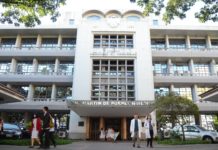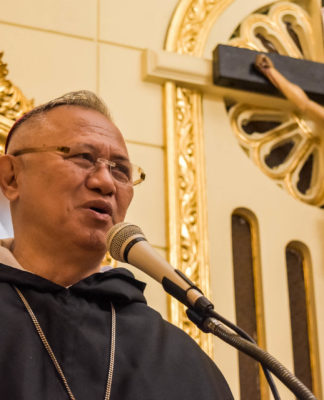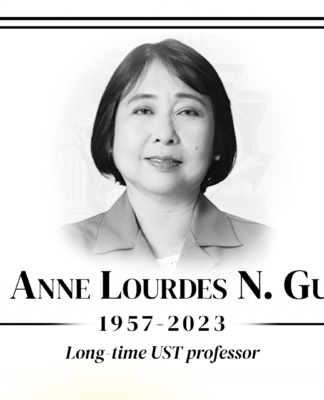A DYNAMIC Chemistry teacher at the College of Science, an outstanding scientist, and a responsible homemaker. Those are only some of the roles Dr. Cristina Aquino Binag juggles everyday.
Though her different hats are tasking and tiring, Binag managed to complete her scientific research on conducting polymers.
Because of her pioneering work on conducting polymers, she was recently awarded as one of this year’s Outstanding Young Scientist (OYS) by the National Academy of Science and Technology (NAST) during its 23rd Scientific Meeting last July 12.
In an interview, Binag told the Varsitarian how pleased she was to receive the award, as it gave credit to her pioneering work.
Inspiration
Binag, an alumna of the Holy Spirit High School in Tarlac, traces her interest in Chemistry to her high school teacher Ms. Lugay. She recalled Lugay making Chemistry interesting through various practical chemistry experiments such as distillation, perfume-making and wines.
“Personally I find teachers a big factor in making Chemistry interesting,” she said.
Binag advocates stirring the interest in Chemistry among high school teachers and students through seminars and entertaining Chemistry demonstrations, such as Chemagic during the annual Science week in the College of Science.
Married and juggling her roles as professor, scientist, and homemaker, Binag finds it a big challenge to balance her time.
Binag is currently secretary of the Kapisanang Kimika ng Pilipinas (KKP), division of Analytical Science, editor in chief of the Philippine Chemistry News and one of the public relations officers of the Philippine Federation of Chemical Societies (PFCS).
Proud to be a Thomasian
“All the while, I wasn’t thinking of myself, but I was bearing the name of UST.” Binag said, when asked what she thought about while receiving the prestigious OYS award. Present during the awarding ceremonies were College of Science Dean Gloria Bernas, Vice Rector Fr. Juan Ponce, O.P., and Assistant to the Rector for Research Planning and Development Dr. Fortunato Sevilla III.
Binag told the Varsitarian that the University has one of the best Chemical Science research groups in the country. Its researches get published regularly in local and international journals. De La Salle University and Ateneo de Manila University looks up to UST for its research output, she added.
Currently the chair of graduate research at the UST Graduate School (USTGS), Binag says she will continue to build linkages with other universities here and abroad. She would also prepare her postgraduate students in presenting their research papers in local and international conferences and encourage them to pursue further education.
A life of research
Binag received her Bachelor’s degree in Chemistry from the University in 1983. She first worked at the filtration and distillation division of Distileria Limtuaco. But her dreams extended far beyond the distillery. She thought that simple chemical testing on alcohol was routinary. Soon after, she developed an eye problem traced to her long exposure to alcohol. She quit her job and decided to go back to the UST Research Center for the Natural Sciences (RCNS) in 1986, with the help of former RCNS director and chemistry professor Mariano Pangan.
“I learned that if you are in the Research and Development Division, mas maganda. You are updated with what’s happening.” Binag said.
As a researcher, she initially worked as an organic chemist in the Natural Products Group, investigating the properties of flavonoids, flavones, and carotenoids under College of Science Prof. Beatrice Guevara.
Later, she shifted to Analytical Chemistry after current Director of the Office for Research and Development (ORD) Dr. Fortunato Sevilla III came back from the United Kingdom and started the analytical chemistry group.
She was passionate with her work at the RCNS and relished the challenges she encountered.
Her explorations in analytical chemistry were further enriched through a scholarship she received while pursuing her masteral degree in Analytical Chemistry at the USTGS. Sponsored by the Australian government and National Economic Development Authority, the grant entitled her to study in the University of New South Wales (UNSW) in Sydney, Australia.
She went to Australia in 1990, leaving her degree in the USTGS unfinished. Being the only woman in a group of 24 scholars from different Philippine universities and institutions, she was the third Thomasian recipient of the Australian doctoral grant. The first two were Dr. Maribel Nonato and Dr. Cecilia Bayquen, both chemistry professors in the College of Science.
She worked with UNSW Profs. Peter Alexander and Robert Lamb. Because of the two, she was able to enhance her skills in electrochemistry and surface chemistry.
Binag’s surface chemistry
Surface Chemistry involves scanning the surface of an object through the ultramicroscopic level measured in nanometers or 10-9 meters. Widely used in industries, this determines the composition of elements on the surface and identifies them.
According to Binag, one may also utilize surface chemistry techniques to find out why adhesives used in certain bottle labels peel off easily. Using an X-ray Photoelectron Spectroscopy (XPS) machine, one may find more carbon particles are present and less silicon in the adhesive compound. Silicon is the main ingredient of adhesives.
Binag also tested the authenticity of Australian banknote samples, which are essentially made of a plastic material.
She also took part in a commercial project for Intel Australia, the world’s largest supplier of computer chips. Through spectroscopy, she analyzed Taiwan-made Intel chips to check if they were real.
The tests found the chips fake, simply because the ink used and the writing strokes of each chip were different from the original.
Polymers
Binag’s work on conducting polymers involved using high-tech instruments in analyzing the composition of her polymer materials. Applying electrochemical techniques, she made these conducting polymers into a sensor.
Her feat in blending the fields of electrochemistry and surface chemistry and her outstanding scientific outputs were published in international journals and caught the attention of the scientific community.
Conducting polymers are plastics embedded with chemicals that can conduct electric current. She used these “electric” plastics to create a pH sensor, a device which measures the acidity or basicity of a solution. Some of the conducting polymers she made were polyaniline, o-phenylenediamine, and polypyrrole. Polypyrrole was used as a biosensor to measure triglyceride or fat levels in the blood, wherein high levels indicate a risk for heart disease.
Sensors
Her idea of making a pH sensor started after investigating the possibility of building sensors and characterizing them with the advanced and expensive facilities available in the UNSW. After approval of the administration, she tinkered on conducting polymers as a main component of the pH sensor.
Commercially available pH sensors are normally equipped with glass electrodes. These are the ones dipped in the test solution. Binag fabricated a pH sensor using conducting polymers, which initially ran on poor performance in each test.
For electrodes, she recalled that mixing the polymer compounds by hand gave poor consistency. Since these have to be homogenous or blended, she utilized electrochemical gadgets like a current limiting device and a galvanostat through these devices, along with surface chemistry instruments like the XPS, she was able to produce her pH sensor with different polymers.
Binag cites the advantages of using polymers in pH sensors. First, they can be miniaturized and therefore used even in droplet-sized samples, something glass electrodes cannot do. Second, polymer-based electrodes are unbreakable and can withstand testing even in corrosive acids.
And lastly, being plastic, it is flexible.
In small amounts, it may be mounted on different support materials such as platinum wire or even carbon rod through electropolymerization. It can test samples in an upside-down position, unlike glass electrodes which can only be used in an upright position.
Likewise, when liquid sample flows horizontally, the polymer electrode can be adjusted to accommodate the sample’s direction.
In addition, the newly-cleaned and polished carbon rods found in used batteries may also be used as a carbon support wire in making the polymer electrode, thus promoting recycling.
Binag, though, is not interested in commercializing the product. She prefers to leave this to enterprise-minded individuals because she wanted to concentrate on research.
Advantages
Binag received her Ph.D degree in 1996. She came back to UST to continue her conducting polymer research at the RCNS and teach at the College of Science.
“I think we have researches that other countries cannot perform. But with proper collaboration with them we could have the same researches.” Binag said.
For her, the Philippines is rich in biodiversity, a requisite to conduct good research. Foreign nations however, can finish research faster due to their access to chemicals, which they locally produce, and with their state-of-the-art instruments.
Binag finds research fulfilling. She encourages Thomasians to take advantage of the many opportunities in furthering their education, through scholarships and accessing the Internet more often to gain information. She also believes that this will enable them to interact with foreign students who may have the same research interests, to help them accomplish their research more efficiently.
















Hello.This post was extremely interesting, particularly
because I was searching for thoughts on this matter last
Thursday.